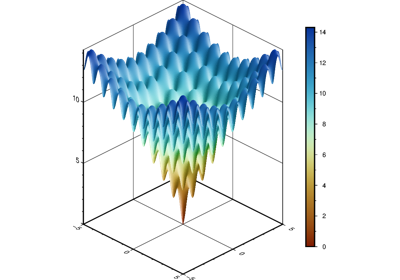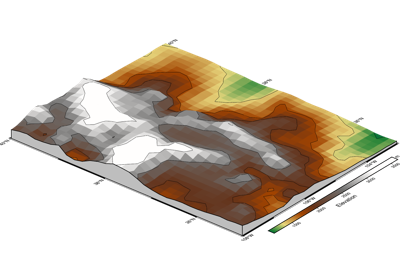pygmt.Figure.grdview
- Figure.grdview(grid, *, region=None, projection=None, zscale=None, zsize=None, frame=None, cmap=None, drapegrid=None, plane=None, surftype=None, contourpen=None, meshpen=None, facadepen=None, shading=None, verbose=None, panel=None, coltypes=None, interpolation=None, perspective=None, transparency=None, **kwargs)
Create 3-D perspective image or surface mesh from a grid.
Reads a 2-D grid file and produces a 3-D perspective plot by drawing a mesh, painting a colored/gray-shaded surface made up of polygons, or by scanline conversion of these polygons to a raster image. Options include draping a data set on top of a surface, plotting of contours on top of the surface, and apply artificial illumination based on intensities provided in a separate grid file.
Full option list at https://docs.generic-mapping-tools.org/6.5/grdview.html
Aliases:
B = frame
C = cmap
G = drapegrid
I = shading
J = projection
JZ = zsize
Jz = zscale
N = plane
Q = surftype
R = region
V = verbose
Wc = contourpen
Wf = facadepen
Wm = meshpen
c = panel
f = coltypes
n = interpolation
p = perspective
t = transparency
- Parameters:
grid (str or xarray.DataArray) –
Name of the input grid file or the grid loaded as a
xarray.DataArrayobject.For reading a specific grid file format or applying basic data operations, see https://docs.generic-mapping-tools.org/6.5/gmt.html#grd-inout-full for the available modifiers.
region (str or list) – xmin/xmax/ymin/ymax[+r][+uunit]. Specify the region of interest. When used with
perspective, optionally append /zmin/zmax to indicate the range to use for the 3-D axes [Default is the region in the input grid].projection (str) – projcode[projparams/]width|scale. Select map projection.
zscale/zsize (float or str) – Set z-axis scaling or z-axis size.
frame (bool, str, or list) – Set map boundary frame and axes attributes.
cmap (str) – The name of the color palette table to use.
drapegrid (str or xarray.DataArray) – The file name or a DataArray of the image grid to be draped on top of the relief provided by grid. [Default determines colors from grid]. Note that
zscaleandplanealways refers to the grid. The drapegrid only provides the information pertaining to colors, which (if drapegrid is a grid) will be looked-up via the CPT (seecmap).plane (float or str) – level[+gfill]. Draw a plane at this z-level. If the optional color is provided via the +g modifier, and the projection is not oblique, the frontal facade between the plane and the data perimeter is colored.
surftype (str) –
Specify cover type of the grid. Select one of following settings:
m - mesh plot [Default].
mx or my - waterfall plots (row or column profiles).
s - surface plot, and optionally append m to have mesh lines drawn on top of the surface.
i - image plot.
c - Same as i but will make nodes with z = NaN transparent.
For any of these choices, you may force a monochrome image by appending the modifier +m.
contourpen (str) – Draw contour lines on top of surface or mesh (not image). Append pen attributes used for the contours.
meshpen (str) – Set the pen attributes used for the mesh. You must also select
surftypeof m or sm for meshlines to be drawn.facadepen (str) – Set the pen attributes used for the facade. You must also select
planefor the facade outline to be drawn.shading (str) – Provide the name of a grid file with intensities in the (-1,+1) range, or a constant intensity to apply everywhere (affects the ambient light). Alternatively, derive an intensity grid from the input data grid reliefgrid via a call to
pygmt.grdgradient; append +aazimuth, +nargs, and +mambient to specify azimuth, intensity, and ambient arguments for that function, or just give +d to select the default arguments [Default is +a-45+nt1+m0].Select verbosity level [Default is w], which modulates the messages written to stderr. Choose among 7 levels of verbosity:
q - Quiet, not even fatal error messages are produced
e - Error messages only
w - Warnings [Default]
t - Timings (report runtimes for time-intensive algorithms)
i - Informational messages (same as
verbose=True)c - Compatibility warnings
d - Debugging messages
panel (bool, int, or list) – [row,col|index]. Select a specific subplot panel. Only allowed when in subplot mode. Use
panel=Trueto advance to the next panel in the selected order. Instead of row,col you may also give a scalar value index which depends on the order you set viaautolabelwhen the subplot was defined. Note: row, col, and index all start at 0.coltypes (str) – [i|o]colinfo. Specify data types of input and/or output columns (time or geographical data). Full documentation is at https://docs.generic-mapping-tools.org/6.5/gmt.html#f-full.
interpolation (str) –
[b|c|l|n][+a][+bBC][+c][+tthreshold]. Select interpolation mode for grids. You can select the type of spline used:
b for B-spline
c for bicubic [Default]
l for bilinear
n for nearest-neighbor
perspective (list or str) – [x|y|z]azim[/elev[/zlevel]][+wlon0/lat0[/z0]][+vx0/y0]. Select perspective view and set the azimuth and elevation angle of the viewpoint [Default is
[180, 90]]. Full documentation is at https://docs.generic-mapping-tools.org/6.5/gmt.html#perspective-full.transparency (float) – Set transparency level, in [0-100] percent range [Default is
0, i.e., opaque]. Only visible when PDF or raster format output is selected. Only the PNG format selection adds a transparency layer in the image (for further processing).
Example
>>> import pygmt >>> # load the 30 arc-minutes grid with "gridline" registration >>> # in a specified region >>> grid = pygmt.datasets.load_earth_relief( ... resolution="30m", ... region=[-92.5, -82.5, -3, 7], ... registration="gridline", ... ) >>> # create a new figure instance with pygmt.Figure() >>> fig = pygmt.Figure() >>> # create the contour plot >>> fig.grdview( ... # pass in the grid downloaded above ... grid=grid, ... # set the perspective to an azimuth of 130° and an elevation of 30° ... perspective=[130, 30], ... # add a frame to the x- and y-axes ... # specify annotations on the south and east borders of the plot ... frame=["xa", "ya", "wSnE"], ... # set the projection of the 2-D map to Mercator with a 10 cm width ... projection="M10c", ... # set the vertical scale (z-axis) to 2 cm ... zsize="2c", ... # set "surface plot" to color the surface via a CPT ... surftype="s", ... # specify CPT to "geo" ... cmap="geo", ... ) >>> # show the plot >>> fig.show()

